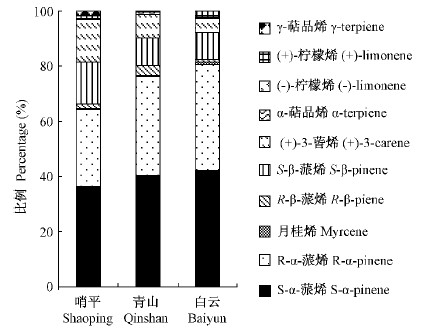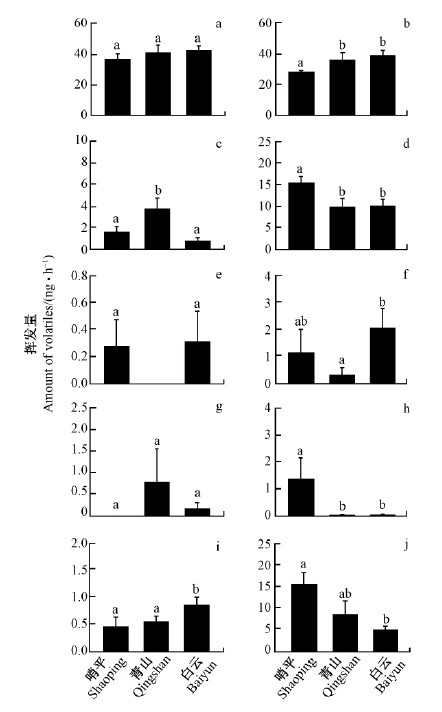文章信息
- 张苏芳, 张真, 孔祥波, 王鸿斌, 蔡道雄, 陶怡
- Zhang Sufang, Zhang Zhen, Kong Xiangbo, Wang Hongbin, Cai Daoxiong, Tao Yi
- 马尾松毛虫常灾区、偶灾区和无灾区松针挥发物特征
- Volatile Characters of Masson Pine Needles from Dendrolimus punctatus Frequent Outbreak Area, Occasional Outbreak Area, and Non-Outbreak Area
- 林业科学, 2015, 51(3): 170-174
- Scientia Silvae Sinicae, 2015, 51(3): 170-174.
- DOI: 10.11707/j.1001-7488.20150322
-
文章历史
- 收稿日期:2013-11-25
- 修回日期:2014-07-04
-
作者相关文章
2. 中国林业科学研究院热带林业实验中心 凭祥 532600
2. Experimental Center of Tropical Forestry, CAF Pingxiang 532600
马尾松(Pinus massoniana)是我国南方广泛分布的乡土树种,适应性强,经济价值高。然而,随着马尾松纯林面积的不断增多,害虫也频繁暴发。其中,马尾松毛虫(Dendrolimus punctatus)是最重要的针叶林食叶害虫(萧刚柔,1992),一旦暴发,种群密度极高,幼虫大量取食松针,危害严重时能够引起球果减产,影响树木生长甚至引起树木死亡(赵成华等,1993)。为有效防控该害虫暴发,目前只能大面积使用化学农药,这使生态系统中生物多样性的维持和天敌的生存受到严重影响。因此,亟需找到一种更科学的防治方法。
根据松毛虫暴发情况的不同马尾松林可以分为常灾区、偶灾区和无灾区(张真等,2005)。无灾区的节肢动物群落结构要比常灾区复杂,这表明昆虫种间竞争可能会限制马尾松毛虫的暴发(李新航等,2009;张真等,2005)。然而,不同暴发区松树的生理特征是否与松毛虫暴发过程有一定的相关性还不清楚。
植物碳含量的相当一部分是通过挥发性有机物(volatile organic compounds,VOCs)的形式释放到大气系统中的,当植物受到植食性害虫的攻击时,这些挥发物的释放量还会增加。植物被昆虫侵害后的VOCs常被称为植食性昆虫诱导的植物挥发物(herbivore-induced plant volatiles,HIPVs)。植物挥发物能够介导植物很多重要的生态过程(Holopainen,2004),如通过授粉、吸引天敌来达到间接防御的目的等(Kessler et al.,2001)。对马尾松挥发物的种类已进行鉴定(赵成华等,1995; Su et al.,2009),并且发现其中的某些化合物可以引起马尾松毛虫EAG活性和行为反应(赵成华等,1995;2003),甚至可以吸引马尾松毛虫的天敌昆虫(王勇等,2008)。
笔者对广西凭祥市大青山3个典型松毛虫暴发区域的松针挥发物进行鉴定和比较,旨在分析不同暴发区松针挥发物与松毛虫暴发之间是否存在相关性,为阐明松毛虫暴发机制及寻找有效的害虫控制方法提供参考。
1 材料与方法 1.1 试验样地在广西凭祥大青山区域共选择3个试验场地,即无灾区(白云林场)、偶灾区(青山林场)、常灾区(哨平林场)。林场海拔200~400 m,松树树龄5~8年。
1.2 挥发物收集、鉴定与定量1)挥发物收集 挥发物收集采用Wei等(2006)报道的方法,并作适当改进。把健康的松针套进干净的收集袋中[40.6 cm× 44.4 cm(Reynolds Oven Bags,Reynolds Kitchens,Richmond,VA,USA)],利用大气采样仪(北京劳保研究所)将活性炭过滤后的干净空气泵入收集袋内。空气流速为400 mL ·min-1。流过松针的空气被装有Porapak Q(80~100目,Supelco,USA)吸附剂的吸附管收集1 h。每个样地都采集至少8株马尾松的针叶挥发物作为重复。收集完成后,立即用1 mL HPLC 级的正己烷淋洗吸附管,将淋洗液收集于2 mL 的样品瓶中。样品存于-20 ℃ 冰箱,分析时取出,待恢复到常温后进行色谱分析。
2)挥发物鉴定与定量分析 利用气相色谱与质谱联用仪GC-MS(Thermo-Finnigan Trace DSQ GC-MS,EI mode,70 eV,美国)对挥发物成分进行鉴定,鉴定方法参考Wei等(2006)。所有顶空样品均使用DB-5MS(内径60 m × 0.25 mm,涂层厚0.15 μm)进行分析。炉温程序是: 30 ℃ 保持5 min后,以每分钟4 ℃的速率到200 ℃,再以每分钟10 ℃的速率升到230 ℃。载气流速1.0 mL ·min-1,进样口设为无分流进样,进样口温度为250 ℃,MS源温度为230 ℃,MS四极杆温度为150 ℃。利用保留时间法,即根据该化合物在2种柱上的保留时间与标准化合物的一致性来确定化合物的成分。标准化合物及其纯度和来源见表 1。松针挥发物的定量分析利用气相色谱GC(7890A; Agilent Technologies,Inc.,Santa Clara,CA,USA)完成。分析过程中使用的色谱柱和升温程序与挥发物鉴定过程一致。GC定量利用外标法定量,即将各物质标准品配成不同浓度梯度后,各浓度分别进样1 mL进行分析,得出各浓度的峰面积后作标准曲线,同样条件下进1 mL待测样品,得出各物质的峰面积,然后根据标准曲线得出各个萜烯类组分的含量。
|
|
数据统计和分析采用ANOVA方法,差异分析采用Tukey’s Honestly Significant Difference(HSD)检测(SPSS 15.0; SPSS Inc.,Chicago,Illinois,USA)。
2 结果与分析 2.1 松毛虫不同暴发区域松针挥发物的组成松针挥发物成分主要包括S-α-蒎烯、R-α-蒎烯、月桂烯、R-β-蒎烯、S-β-蒎烯、(+)-3-蒈烯、α-萜品烯、(+)-柠檬烯、(-)-柠檬烯、γ-萜品烯(图 1)。常灾区哨平林场、偶灾区青山林场、无灾区白云林场的松针挥发物组成却有很大的不同,最明显的区别在于R-α-蒎烯在3个林场松针挥发物中的含量依次升高(P < 0.05),而S-β-蒎烯和(+)-3-蒈烯比依次下降(P < 0.01)(图 1)。
 |
图 1 松毛虫3种暴发区松针挥发物组分 Fig.1 Pine needle volatiles identification and composition from frequent outbreak area Shaoping, occasional outbreak area Qingshan, and non-outbreak area Baiyun |
为深入比较松毛虫不同暴发区松针挥发物的差异,对鉴定到的挥发物在3个林场中的挥发量进行了一一对比,发现这些挥发物可以分为4种类型(图 2):第1类包括R-α-蒎烯和香叶烯,这类挥发物在常灾区、偶灾区、无灾区的松针挥发物中依次显著增加(P < 0.05)。第2类包括S-β-蒎烯、γ-萜品烯和(+)-3-蒈烯,这类挥发物和第1类相反,在常灾区、偶灾区、无灾区的松针挥发物中依次显著减少(P值分别为 < 0.01,< 0.05,< 0.01)。第3类包括R-β-蒎烯和(+)-柠檬烯,它们在3种松毛虫暴发区域的松针挥发物中呈现显著(P < 0.05)但不规则变化;最后一类包括S-α-蒎烯,(-)-柠檬烯和α-萜品烯,它们在3种松毛虫暴发区域的松针挥发物中无明显变化。
 |
图 2 松毛虫3种不同暴发区松针不同挥发物挥发量
Fig.2 Comparison of each chemical’s amount
from pine needles of Shaoping, Qingshan and Baiyun
图中数据为平均值±标准误,不同小写字母表示差异显著
(P < 0.05) Pata(mean±SE) in the Fig.with different small letters are significantly different (P < 0.05). |
测试分析结果发现,害虫不同暴发区的马尾松针叶挥发物具有不同的释放特性。其中2类挥发物的挥发量和松毛虫的暴发频率密切相关,从而揭示了不同马尾松群落的一个重要生理特征,即挥发性有机化合物与马尾松毛虫暴发之间具有相关性。
以前的研究探讨了松毛虫对不同针叶挥发物的行为响应。赵成华等(1995)发现:马尾松毛虫触角对β-蒎烯表现出极高的EAG反应,表明β-蒎烯可能在松毛虫行为调节中具有重要作用。本试验也表明,常灾区的马尾松能够挥发更多的S-β-蒎烯,与前面的试验相吻合。但也有试验表明,马尾松毛虫雌虫在喷洒过β-蒎烯溶液的针叶上产卵量明显减少(赵成华等,2003),这也许是成虫为了避免在同一个地方过多产卵的一种保护机制。另外,以上2项研究都没有区分R-β-蒎烯和S-β-蒎烯这2种异构体,这可能导致R-β-蒎烯呈现不同的作用。对马尾松毛虫的近缘种落叶松毛虫(D.superans)的行为研究发现,其幼虫能够被R-α-蒎烯和(+)-3-蒈烯吸引,而被香叶烯排斥(刘英胜等,2009)。这与本试验中常灾区针叶挥发的引诱性化合物(+)-3-蒈烯挥发量更多而驱避性化合物香叶烯更少的结果相一致,共同证明植物挥发物对害虫种群具有调节作用。分析马尾松毛虫对不同挥发物的行为反应及不同害虫暴发地区马尾松针叶挥发物的组成差异可知,植物挥发物组分比例的变化可能影响不同地区松毛虫的暴发频率。
天敌是控制松毛虫的重要因子,因此,松针挥发物对马尾松毛虫天敌的作用也能影响害虫的暴发。松毛虫赤眼蜂(Trichogramma dendrolimi)是松毛虫卵期的重要天敌,目前该天敌可以通过大规模人工繁殖和释放来加以利用,并在松毛虫控制中起到了重要作用(巫之馨等,1982;杜增庆等,1992;周刚等,2005)。在条件合适的情况下,人工释放赤眼蜂对松毛虫的寄生率最高可达89.8%(方慧兰等,1992)。松毛虫天敌研究和应用最广的就是松毛虫赤眼蜂,已经对其生物学特性、种群动态、林间应用等有了深入了解(徐延熙等,2006)。在寄主昆虫定位机制的研究中发现,松针挥发物混合物能够显著吸引赤眼蜂(柴希民等,1989;邱中良等,1995)。单化合物对赤眼蜂的引诱试验表明,α-蒎烯和β-蒎烯对赤眼蜂的吸引效果最明显(王勇等,2008);然而,该研究没有分析不同异构体是否对赤眼蜂具有不同的引诱作用。本试验中,α-蒎烯和β-蒎烯在不同暴发区域松针挥发物中的组成规律不一致,但是如果把α-蒎烯和β-蒎烯(包含各异构体)作为一个整体来探讨其对赤眼蜂的引诱作用,就会发现其总量在常灾区比在偶灾区和无灾区显著要低〖常灾区(81.22±2.11)ng ·h-1,偶灾区(89.73±3.36)ng ·h-1,无灾区(92.41±1.37)ng ·h-1],这表明无灾区或者偶灾区的针叶挥发物能够吸引更多的赤眼蜂,从而对松毛虫的暴发起一定的控制作用。
| [1] |
柴希民,何志华,吴正东. 1989. 马尾松毛虫卵寄生蜂数量变动研究. 林业科学研究,2 (5):461-468. (Chai X M, He Z H, Wu Z D, 1989. Studies on egg parasitoids of Dendrolimus punctatus Walker. Forest Research, 2 (5):461-468[in Chinese]).(  1) 1)
|
| [2] |
杜增庆,裘学军. 1992. 林间释放赤眼蜂防治马尾松毛虫效果研究. 森林病虫通讯,(1): 8-10. (Du Z Q, Qiu X J. 1992. Effect of releasing Trichogramma dendrolimi Matsumura in forest to control Dendrolimus punctatus Walker. Forest Pest and Disease, (1): 8-10[in Chinese]).(  1) 1)
|
| [3] |
方慧兰,童普元,廉月琰,等. 1992. 松毛虫赤眼蜂对松毛虫抑制作用研究. 昆虫天敌,14 (3): 126-129. (Fang H L, Tong P Y, Lian Y Y, et al. 1992. Controlling effect of Trichogramma dendrolimi Matsumura to control Dendrolimus punctatus Walker. Natural Enemies of Insects, 14 (3): 126-129[in Chinese]).(  1) 1)
|
| [4] |
李新航,张真,马钦彦,等. 2009. 马尾松林节肢动物群落的稳定性. 生态学报,29 (1): 216-222. (Li X H, Zhang Z, Ma Q Y, et al. 2009. Analysis of arthropod community stability in Masson pine forest. Acta Ecologica Sinica, 29 (1): 216-222[in Chinese]).(  1) 1)
|
| [5] |
刘英胜,严善春,程红,等. 2009. 落叶松毛虫对兴安落叶松9种挥发性物质的行为反应. 林业科学,45 (4): 72-77. (Liu Y S, Yan S C, Cheng H, et al. 2009. Behavioural responses of Dendrolimus superans to Dahurin Larch and its nine volatile. Scientia Silvae Sinicae, 45 (4): 72-77[in Chinese]).(  1) 1)
|
| [6] |
邱中良,周建中,黄娟,等. 1995. 松毛虫赤眼蜂雄蜂寄主栖息地定向行为的研究. 昆虫天敌,17 (1): 1-6. (Qiu Z L, Zhou J Z, Huang J, et al. 1995. Studies on the host-habitat location behavior of male Trichogramma dendrolimi. Natural Enemies of Insects, 17 (1): 1-6[in Chinese]).(  1) 1)
|
| [7] |
王勇,肖铁光,何忠,等. 2008. 马尾松树针叶挥发物性化学物质对松毛虫赤眼蜂嗅觉及寄生行为的影响. 昆虫知识,45 (6): 944-949. (Wang Y, Xiao T G, He Z, et al. 2008. Effects of masson pine volatiles on olfactory and parasitic behavior of Trichogramma dendrolimi. Chinese Bulletin of Entomology, 45 (6): 944-949[in Chinese]).(  2) 2)
|
| [8] |
巫之馨,钦俊德,李同修,等. 1982. 以无昆虫物质的人工饲料培育松毛虫赤眼蜂幼虫. 昆虫学报,25 (2): 132-135. (Wu Z X, Qin J D, Li T X, et al. 1982. Culturing Trichogramma dendrolimi in vitro with artificial media devoid of insect materials. Acta Entomologica Sinica, 25 (2): 132-135[in Chinese]).(  1) 1)
|
| [9] |
萧刚柔. 1992. 中国森林昆虫. 北京: 中国林业出版社. (Xiao G R. 1992. Forest Insects of China. Beijing: China Forestry Publishing House.[in Chinese])(  1) 1)
|
| [10] |
徐延熙,孙绪艮,韩瑞东,等. 2006. 我国马尾松毛虫寄生性天敌的研究进展. 昆虫知识,43 (6): 767-773. (Xu Y X, Sun X G, Han R D, et al. 2006. Parasitoids of Dendrolimus punctatus in China. Chinese Bulletin of Entomology, 43 (6): 767-773[in Chinese]).(  1) 1)
|
| [11] |
张真,王淑芬,吴东亮,等. 2005. 马尾松林食叶类群昆虫多样性及相互关系. 昆虫知识,42 (1): 36-40. (Zhang Z, Wang S F, Wu D L, et al. 2005. Divesity and relationships of defoliators in Masson pine Pinus Massoniana. Chinese Bulletin of Entomology, 42 (1): 36-40[in Chinese]).(  2) 2)
|
| [12] |
赵成华,李群,郭星宇,等. 1993. 马尾松毛虫性外激素的新成分: 化学结构鉴定和田间试验. 昆虫学报,36 (2): 247-250. (Zhao C H, Li Q, Guo X Y, et al. 1993. New components of sex pheromone in the pine caerpillar moth, Dendrolimus punctatus: Identification of chemical structures and field tests. Acta Entomologica Sinica, 36 (2): 247-250[in Chinese]).(  1) 1)
|
| [13] |
赵成华,伍德明,阎云花,等. 1995. 马尾松针叶中挥发性成分的鉴定及其对马尾松毛虫的触角电位反应. 林业科学,31(2): 125-131. (Zhao C H, Wu D M, Yan Y H, et al. 1995. Analysis of Masson pine needle volatiles and their electroantennogram activity with Masson pine caterpillar. Scientia Silvae Sinicae, 31(2): 125-131[in Chinese]).(  2) 2)
|
| [14] |
赵成华,阎云花. 2003. 马尾松针叶中的挥发物质对马尾松毛虫产卵行为的影响. 林业科学,39 (6): 91-93. (Zhao C H, Yan Y H. 2003. Oviposition behaviour of the pine caterpillar moth, Dendrolimus punctatus influenced by needle volatiles of Pinus massoniana. Scientia Silvae Sinicae, 39 (6): 91-93[in Chinese]).(  2) 2)
|
| [15] |
周刚,黄向东,张玉荣,等. 2005. 赤眼蜂大面积防治不同类型区马尾松毛虫试验. 湖南林业科技, 32 (4): 46-48. (Zhou G, Huang X D, Zhang Y R, et al. 2005. The large area preventing and control experiment of the D. punctatus in different types by T. dendrolimus. Hunan Forestry Science & Technology, 32 (4): 46-48[in Chinese]).(  1) 1)
|
| [16] |
Holopainen J K. 2004. Multiple functions of inducible plant volatiles. Trends in Plant Science, 9 (11): 529-533.( 1) 1)
|
| [17] |
Kessler A, Baldwin I T. 2001. Defensive function of herbivore-induced plant volatile emissions in nature. Science, 291 (5511): 2141-2144.( 1) 1)
|
| [18] |
Su J W, Zeng J P, Qin X W, et al. 2009. Effect of needle damage on the release rate of Masson pine (Pinus massoniana) volatiles. Journal of Plant Research, 122 (2): 193-200.( 1) 1)
|
| [19] |
Wei J N, Kang L. 2006. Electrophysiological and behavioral responses of a parasitic wasp to plant volatiles induced by two leaf miner species. Chemical Senses, 31 (5): 467-477.( 2) 2)
|
 2015, Vol. 51
2015, Vol. 51

